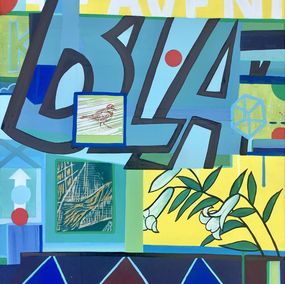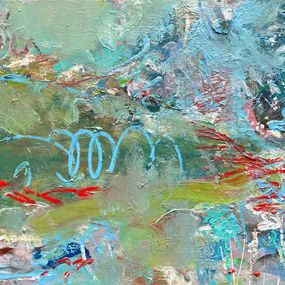
Abstract Painting for Sale
Save your search and find it in your favorites
Save your search to find it quickly
Saved search
Your search is accessible from the favorites tab > My favorite searches
Unsaved search
A problem occurred



Rock Candy, Painting, Acrylic on Canvas
Sally Adams
Painting - 76.2 x 101.6 x 3.8 cm Painting - 30 x 40 x 1.5 inch
$2,965




Sweet blue rock - Série Les Minérales
Dam Domido
Painting - 85 x 150 x 0.01 cm Painting - 33.5 x 59.1 x 0 inch
$3,711

Basket
Leonardo Aguirre di Matteo
Painting - 100 x 100 x 2 cm Painting - 39.4 x 39.4 x 0.8 inch
$2,552


L’encre des mots clés
Cécile Jaunet
Painting - 228 x 100 x 1 cm Painting - 89.8 x 39.4 x 0.4 inch
$8,118



Untitled - Serie desde el aire 1/6
Catalina Sampol
Painting - 30 x 30 x 4 cm Painting - 11.8 x 11.8 x 1.6 inch
$580


Les quatre saisons : Soleil d'Automne
Odile Pinto-Corbin
Painting - 70 x 70 x 3 cm Painting - 27.6 x 27.6 x 1.2 inch
$1,972 $1,774



Girl with flowers in her hand
Igor Volkov-Tkachinskiy
Painting - 80 x 70 x 2 cm Painting - 31.5 x 27.6 x 0.8 inch
$600
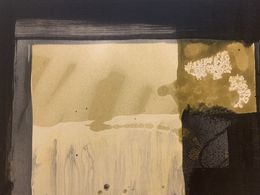


Le tourbillon de la vie
Christiane Bernais
Painting - 100 x 80 x 1.8 cm Painting - 39.4 x 31.5 x 0.7 inch
$1,682

Size XL - Tout ira bien N°2
Anaïs LF
Painting - 90 x 68 x 2 cm Painting - 35.4 x 26.8 x 0.8 inch
$1,392



Orb (Blue and Violet)
Brent Hallard
Painting - 91.5 x 91.5 x 0.1 cm Painting - 36 x 36 x 0 inch
$8,081

Red Eye #5, Painting, Oil on Wood Panel
Relja Penezic
Painting - 61 x 61 x 3.8 cm Painting - 24 x 24 x 1.5 inch
$3,700

Joyous Beginnings
Paulette Insall
Painting - 76.2 x 76.2 x 3.8 cm Painting - 30 x 30 x 1.5 inch
$3,497



Swirl Zero One
Jens-Christian Wittig
Painting - 119.4 x 119.4 x 4.3 cm Painting - 47 x 47 x 1.7 inch
$8,000

Longtemps retombent en silence les pétales de rose
Manuela Paul-Cavallier
Painting - 35 x 35 x 2 cm Painting - 13.8 x 13.8 x 0.8 inch
$1,624


Pic Nic
Kittisak Taweekitpinyo
Painting - 120 x 120 x 4 cm Painting - 47.2 x 47.2 x 1.6 inch
$3,015 $2,865





Iles Muettes 2 - oeuvre imaginaire tournée vers le voyage, la poésie et le rêve
Valérie Piquard
Painting - 20 x 20 x 2 cm Painting - 7.9 x 7.9 x 0.8 inch
$116


Al compás de la 5ta sinfonía
Claudia Gallardo
Painting - 81 x 81 x 2 cm Painting - 31.9 x 31.9 x 0.8 inch
$3,066

Direction Ouest
Gilbert Sabatier
Painting - 70 x 50 x 1.8 cm Painting - 27.6 x 19.7 x 0.7 inch
$1,856 $1,577



Poulailler's love
Françoise Leblond
Painting - 30 x 60 x 1.7 cm Painting - 11.8 x 23.6 x 0.7 inch
$1,854


The magic of emerald dragon
Andrei Shchurok
Painting - 130 x 115 x 2.5 cm Painting - 51.2 x 45.3 x 1 inch
$6,379
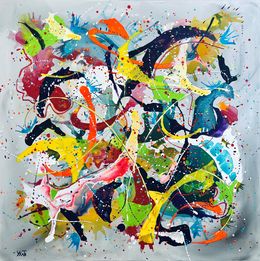





Time after Time
Elen Karapetyan
Painting - 120 x 120 x 2 cm Painting - 47.2 x 47.2 x 0.8 inch
$3,131

Marina 6 - Paysage semi abstrait, série des Marinas
Catherine Le Bras-Hippert
Painting - 30 x 30 x 0.1 cm Painting - 11.8 x 11.8 x 0 inch
$452

Totem Series I
Ewelina Skowronska
Painting - 120 x 100 x 4 cm Painting - 47.2 x 39.4 x 1.6 inch
$6,827

Paysage en Expansion
Eugène de Kermadec
Painting - 97 x 130 x 4 cm Painting - 38.2 x 51.2 x 1.6 inch
$16,817





Left (paper) pieces : unknown world
Hansol Yoon
Painting - 44.7 x 27 x 1 cm Painting - 17.6 x 10.6 x 0.4 inch
$1,867
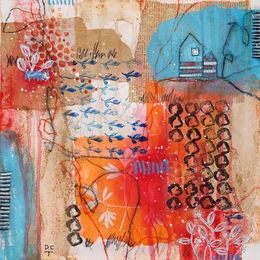
La petite maison bleue
Denise Crolle-Terzaghi
Painting - 30 x 30 x 0.1 cm Painting - 11.8 x 11.8 x 0 inch
$278

Calendula 02, Painting, Acrylic on Canvas
Paul Scat
Painting - 100.1 x 100.1 x 4.1 cm Painting - 39.4 x 39.4 x 1.6 inch
$2,500


Tante Suzanne - Visage figuratif laine feutrée
Josée Mesnard
Painting - 20 x 20 x 2 cm Painting - 7.9 x 7.9 x 0.8 inch
$157


Délire végétal - Monde de la nature, Art cire d'abeilles
Elise Pioger
Painting - 20 x 20 x 3.5 cm Painting - 7.9 x 7.9 x 1.4 inch
$290



Galaxy, Painting, Acrylic on Canvas
Orlando Marin
Painting - 121.9 x 94 x 7.6 cm Painting - 48 x 37 x 3 inch
$4,500


Emotions - Abstraction colorée
Amalya Nané Tumanian
Painting - 19 x 19 x 0.2 cm Painting - 7.5 x 7.5 x 0.1 inch
$406

La vraie lumière n’est perceptible que dans l'obscurité
Olivier Toma
Painting - 81 x 100 x 2 cm Painting - 31.9 x 39.4 x 0.8 inch
$5,080

Oeuvre sans titre
Somsak Hanumas
Painting - 100 x 100 x 3 cm Painting - 39.4 x 39.4 x 1.2 inch
$16,817


Vénus sort ce soir
Christophe Vilar
Painting - 90 x 117 x 5 cm Painting - 35.4 x 46.1 x 2 inch
$6,959


The Tenderest Thing
Patricia J Finley
Painting - 76.2 x 101.6 x 5.1 cm Painting - 30 x 40 x 2 inch
$3,350







Mediterranée, Le Blanc
Isabelle Fournet
Painting - 97 x 130 x 2 cm Painting - 38.2 x 51.2 x 0.8 inch
$2,957
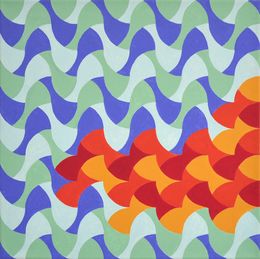

Abstract alchemy - Black floating frame
Belart Collective
Painting - 80 x 120 x 2 cm Painting - 31.5 x 47.2 x 0.8 inch
$3,816


Free composition no.13
Karl-Karol Chrobok
Painting - 53.5 x 37 x 0.3 cm Painting - 21.1 x 14.6 x 0.1 inch
$557


Feel the day calling you
Barbara Piller
Painting - 70 x 60 x 3 cm Painting - 27.6 x 23.6 x 1.2 inch
$1,012



Quand rêvent les nuages 1 - Art abstrait
Virginie Banas
Painting - 20 x 20 x 0.1 cm Painting - 7.9 x 7.9 x 0 inch
$365
Discover the styles & movements
Discover the selection of our experts
Abstract Painting for Sale
Abstract painting is a form of expression which contrasts with representational art, where capturing the likeness of the subject is presented as the artist's ultimate objective. Abstract painting is in fact the very opposite of figurative art. Even if we are not able to understand the meaning behind an abstract work without additional information, it can nonetheless succeed in conveying a sense of emotion and feeling.
We tend to associate the birth of abstraction with the artist Vassily Kandinsky and the artistic revolution he initiated during the 20th century. As one of the movement's pioneers, he was at the forefront of the breakaway from representational art along with Kazimir Malevich, Piet Mondrian and Kupka. Kandinsky not only shared his views on abstraction through his art but also in his written work. In 1910 he published his book “Concerning the Spiritual in Art" in which he defended the symbolic importance of each of the elements present in painting and which gave each artwork a spiritual dimension. In the same year, he unveiled his first abstract piece, entitled “Abstract watercolor". Abstract art was born. Figurativism had been left to one side in favour of a new movement where artists dealt directly with the intangible and immaterial, without explicitly identifying a subject matter. Several sub-genres started to emerge. Kazimir Malevich became known for his legendary 1915 painting “Black Square", followed by “White on White" in 1918, with which he laid the foundations for Suprematism. Malevich believed that a painting was composed of an ensemble of independent forces which could evolve together in the order to find a sense of harmony and equilibrium within the work. Abstraction can also take on a more lyrical form, especially when accompanied by music. Kandinsky's the “Picture with the Black Arch" is an excellent example of this. The large-scale painting was painted in 1912 and is seen as a marking the turning point for a new era in the history of art.
As well as his work on the composition of shapes and colors, Kandinsky had synesthesia. His condition can be seen as a decisive factor in triggering the artist's desire to create a new artistic language. His senses intertwined and became one, transforming sounds into shapes and colors. Kandinsky's use of color is much more than a question of aesthetics; it was inherent to the way he perceived the world. In this abstract painting, each color has been carefully chosen and is filled with symbolic meaning. In his abstract two-dimensional painting, Kandinsky succeeds in ensuring that the spectator can feel and hear an entire orchestra playing a Wagner opera.
Geometric abstraction both stems from and contrasts with lyrical abstraction, which geometric abstract artists summarized as “abstract landscaping". As its name suggests, this new form of abstraction is centred around the use of geometric shapes to create a sense of purity in the painting. Lines, squares, triangles and circles all collide with the use of bold, block colors on a two-dimensional surface. Kupka was one of the movement's leading figures but nonetheless did not want to be associated with it, believing that art should be the very opposite of abstract; it should be concrete and real. Alongside him, Mondrian laid the foundations for geometric abstraction with his characteristic use of neat shapes and rectangles. The artist developed his unique style by structuring his paintings around an underlying orthogonal grid and using sharp right angles.
And last but not least, it is important to remember the influence that both Sonia and Robert Delaunay had on the development of abstraction. The couple seduced the French critic and poet Guillaume Apollinaire with their circular shapes and use of color. Apollinaire christened their art Orphism, a reference to the mythological Greek figure Orpheus as well as to the title of one of his own poems, which he felt was reminiscent of the 'luminous language' conveyed in their paintings. In this regard, Orphism seems to have more in common with lyrical rather than geometric abstraction.
Although abstract art marked a decisive break from prior artistic traditions, the movement can also be seen as the inevitable and logical result of the work and thinking of previous artists. At the start of the century the Fauvist movement explored the importance of color, whilst the Cubists started to deconstruct shapes and play with geometry. In a similar way, German Expressionism, which was born in 1905, encouraged the idea that independent emotions, detached from reality, should be the focus of an artist's work. Thanks to abstraction, modern art has been able to excel and reach its very peak. By no longer focusing on physical subjects, artists are no longer limited to representing recognisable reality.
Abstract art has a universal language to share and convey. Since its beginnings, abstraction has been significantly shared across the world and has contributed a great deal to contemporary thinking today. Explore abstract artworks from renowned artists like Henri Matisse, Jackson Pollock, Mark Rothko, and more on Artsper!
Abstract painting refers to the type of painting that does not make visual reference to the real world. Art that does aim to do this is called figurative art. Instead, abstract art uses some combination of color, shape, line, forms and marks to achieve an outcome. This often allows the viewer the freedom to interpret the work independently and to assign to it their own meaning.
Like most art forms, abstract painting is as easy as the effort that is put into it. While someone could theoretically create an easy abstract artwork, the ones that are remembered and that resonate with their audience are certainly not easy to create. They require an excellent understanding of visual language such as shape, color and form, as well as advanced technical skills to execute them.
To create an abstract painting, you will require at least some form of surface, such as canvas, paper or wood, and paint, such as acrylic, oil or watercolor.


















